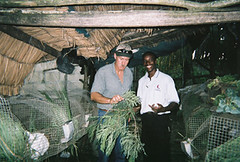Rabbits Big Business in Haiti
 COLLEGE STATION – While most Americans probably associate rabbits with Easter bunnies and batteries, they can mean a better life in Haiti. Backyard domesticated rabbit production in that country – where the average monthly income is only about $50 per month – can double or triple a household's wealth, said Dr. Jeff Tomberlin, Texas Cooperative Extension entomologist.
COLLEGE STATION – While most Americans probably associate rabbits with Easter bunnies and batteries, they can mean a better life in Haiti. Backyard domesticated rabbit production in that country – where the average monthly income is only about $50 per month – can double or triple a household's wealth, said Dr. Jeff Tomberlin, Texas Cooperative Extension entomologist.
A single adult rabbit can be sold for $3.50 U.S., Tomberlin said.v"A good rabbit farmer can sell about six rabbits per week, which translates into a substantial increase in their monthly income," he said.vTomberlin and Dr. Jim Muir, forage researcher with the Texas Agricultural Experiment Station, recently traveled to Cap-Haitian, Haiti, to help farmers develop rabbits as a commodity. The two experts went on a grant from the Farmer to Farmer program funded by USAID program. That program was authorized by the U.S. Congress in 1985.
While there, Tomberlin and Muir, both of Stephenville, visited rabbitries and discussed animal nutrition and integrated pest management with producers. They also gave an introductory course on rabbit production, and presented lectures to students at the Centre D'Agriculture St. Benabas.
Rabbit production in Haiti is largely a backyard proposition. Families raise what they can eat and sell the rest, Tomberlin said. According to the World Factbook, Haiti – which occupies an area slightly smaller than the state of Maryland – is the poorest country in the Western Hemisphere. About two-thirds of the people there depend on small-scale subsistence farming. The most important accomplishment of the trip was getting producers excited about good nutrition for their rabbits using local forbs species, he said.
"Good nutrition is the best way to avoid all sorts of problems, for us (humans) as well as rabbits," Muir said. Producers in Haiti raise animals in wood-framed cages with wire mesh floors and sides of mesh and bamboo. They provide plenty of shade and water for the animals, Muir said. The greatest need was in the area of nutrition for the rabbits, Producers needed to depend less on grasses, which have excessively high fiber, and more on forbs, which have greater digestibility, he said. Forbs in the area included cultivated (sweet potatoes) and weedy (beggar's tick) varieties/types.
He also recommended that forages be kept off of cage floors where they come into contact with excrement and endanger rabbit health. Tomberlin focused on educating producers on the importance of integrated pest management. The primary arthropod pests of rabbits are ear mites, mange, ticks and flies that colonize animal wastes, he said. The integrated pest management approach for rabbit production is similar to that for any other confined animal operation, he said. Facilities should be kept clean, animals kept healthy to reduce mortality and illness, and insecticides should be used sparingly.
"The same problems with confined animal facilities are encountered world wide," Tomberlin said. "Individuals in Haiti demonstrated that managing arthropod pests can truly be done without a reliance on insecticides. They have to due to the fact that they have little money or access to the insecticides." On a personal level, the experience for both A&M scientists was rewarding, they said. Traveling from high-tech Dallas-Fort Worth International Airport to the rutted dirt tracks of Cap-Haitien in a matter of hours made them realize how great the differences are between Texas and Hatian producers. Despite the difficulties they face, however, Hatian farmers were as friendly, hospitable and friendly as any in the U.S., Muir said.
Writer:
Edith A. Chenault, (979) 845-2886,e-chenault1@tamu.edu
Contacts:
Dr. Jim Muir, (254) 968-4144,j-muir@tamu.edu
Dr. Jeff Tomberlin, (254) 968-4144,jktomberlin@ag.tamu.edu
Add new comment